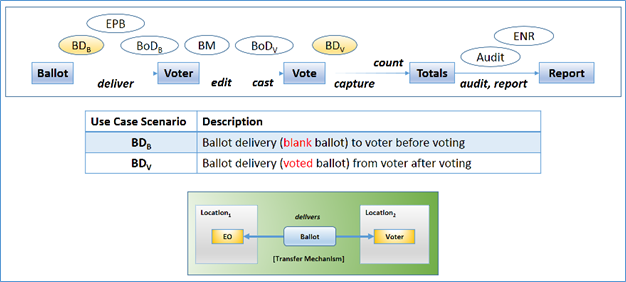Security of Ballot Delivery
READ-ONLY SITE MATERIALS: Historical voting TWiki site (2015-2020) ARCHIVED from https://collaborate.nist.gov/voting/bin/view/Voting
This topic is for discussions of security-related issues associated with the Ballot Delivery Use Case

Security Considerations
Information Types:
- Ballot styles
Security Objectives and Impact Levels
- Confidentiality: Low
- Integrity: Moderate
- Availability: Moderate
Notes:
- Ballot marking considerations should be discussed on the Ballot Marking Security topic.
- Scenarios include:
- Blank Ballot Delivery
- Polling place voting systems
- Postal mail
- Electronic (e.g., email, web)
- Voted Ballot Return
- Polling place voting systems
- Postal mail
- Electronic (e.g., email, web)
- Blank Ballot Delivery
- There are few unique security considerations for ballot distribution in polling places, beyond those covered by Ballot On Demand Security or Ballot Marking Security.
- Electronic Blank Ballot Delivery- Major Security Considerations:
- Ability to reliably match voters to ballot style
- Integrity of blank ballots
- Availability of the system
- Electronic Ballot Return- Major Security Considerations:
- This is a form of Internet voting
- Major challenges include the auditibility of such systems, the ability to authenticate voters while maintaining voter privacy, and the ability to protect against malware.
- See the resources identified at the bottom of this topic for more information
VVSG Security Gap Analysis
Applicability of the VVSG 1.1 and/or draft VVSG 2.0
- VVSG 1.1: Absentee voting systems out-of-scope
- VVSG 2.0: Absentee voting systems out-of-scope
Estimated Level-of-Effort to Address
- Polling Place Systems: Minimal- already addressed or addressed by other use cases
- Absentee/Remote Voting:
- Electronic Ballot Delivery: Moderate- while these systems are very different from polling place systems, general cybersecurity best practices for IT systems could be applied and tailored to online blank ballot delivery portals. Guidelines could have significant overlap with online voter registration database guidelines under the Vrdb Security use case.
- Electronic Ballot Return: High- there are fundamental challenges in technology and the supporting infrastructure.
Gap Areas
- Blank Ballot Delivery
- Voted Ballot Return
Related Resources:
- NIST IR 7551, A Threat Analysis on UOCAVA Voting Systems
- NIST IR 7770, Security Considerations for Remote Electronic UOCAVA Voting
- EAC's UOCAVA Remote Electronic Absentee Voting Pilot Project
Voting TWiki Archive (2015-2020): read-only, archived wiki site, National Institute of Standards and Technology (NIST)
ARCHIVE SITE DESCRIPTION AND DISCLAIMER
This page, and related pages, represent archived materials (pages, documents, links, and content) that were produced and/or provided by members of public working groups engaged in collaborative activities to support the development of the Voluntary Voting System Guidelines (VVSG) 2.0. These TWiki activities began in 2015 and continued until early 2020. During that time period, this content was hosted on a Voting TWiki site. That TWiki site was decommissioned in 2020 due to technology migration needs. The TWiki activities that generated this content ceased to operate actively through the TWiki at the time the draft VVSG 2.0 was released, in February of 2020. The historical pages and documents produced there have been archived now in read-only, static form.
- The archived materials of this TWiki (including pages, documents, links, content) are provided for historical purposes only.
- They are not actively maintained.
- They are provided "as is" as a public service.
- They represent the "work in progress" efforts of a community of volunteer members of public working groups collaborating from late 2015 to February of 2020.
- These archived materials do not necessarily represent official or peer-reviewed NIST documents nor do they necessarily represent official views or statements of NIST.
- Unless otherwise stated these materials should be treated as historical, pre-decisional, artifacts of public working group activities only.
- NIST MAKES NO WARRANTY OF ANY KIND, EXPRESS, IMPLIED OR STATUTORY, INCLUDING, WITHOUT LIMITATION, THE IMPLIED WARRANTY OF MERCHANTABILITY, FITNESS FOR A PARTICULAR PURPOSE, NON-INFRINGEMENT AND DATA ACCURACY.
- NIST does not warrant or make any representations regarding the correctness, accuracy, reliability or usefulness of the archived materials.
ARCHIVED VOTING TWIKI SITE MATERIALS
This wiki was a collaborative website. NIST does not necessarily endorse the views expressed, or concur with the facts presented on these archived TWiki materials. Further, NIST does not endorse any commercial products that may be mentioned in these materials. Archived material on this TWiki site is made available to interested parties for informational and research purposes. Materials were contributed by Participants with the understanding that all contributed material would be publicly available. Contributions were made by Participants with the understanding that that no copyright or patent right shall be deemed to have been waived by such contribution or disclosure. Any data or information provided is for illustrative purposes only, and does not imply a validation of results by NIST. By selecting external links, users of these materials will be leaving NIST webspace. Links to other websites were provided because they may have information that would be of interest to readers of this TWiki. No inferences should be drawn on account of other sites being referenced, or not referenced, from this page or these materials. There may be other websites or references that are more appropriate for a particular reader's purpose.

